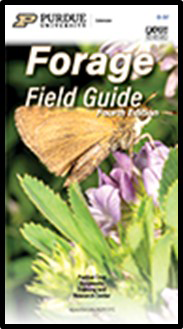There are many challenges with forage production and utilization. There are some tools that can improve yield, quality, and persistence of forages. Consider acquiring the “tools” that you do not have as the 2024 growing season begins.
Resource information – The Purdue Forage Field Guide and subscriptions to forage magazines have great value if information learned is utilized in the forage business. The 4th edition of the Purdue Forage Field Guide was released in late 2023. It can be purchased through the following link Forage Field Guide, fourth edition (purdue.edu). The Guide has over 300 pages of useful information about forage identification, production, and utilization.
Calendar – Having a computer-based calendar or a desk calendar with room for taking notes on each day has value. Observations, tasks accomplished, and weather notes can prove to be valuable. If problems occur, the data may be helpful in better defining the cause of the concern.
Soil probe – A heavy-duty soil probe for collecting soil samples is preferred to a spade or shovel. Avoid nutrient deficiencies and excess fertilization by sending soil samples to a soil testing laboratory and following through with needed recommendations. OSU Extension Publishing
Weed Control Guide – Purdue University, Ohio State University, and the University of Illinois have an outstanding publication provides that provides herbicide options for problematic weeds in common agronomic crops, including alfalfa and grass pastures. 2024 Weed Control Guide for Ohio, Indiana, and Illinois (purdue.edu)
Sweep net – Do you have harmful or beneficial insects? The sweep net is an excellent way to determine whether one should be concerned about an insect pest, especially potato leafhopper in alfalfa.
Moisture tester – Ever made moldy hay? Worse yet, have you ever had a hay storage structure burn from hot hay? Using a moisture tester to determine if hay is at the correct moisture for packaging can minimize these concerns.
Thermometer – Testing hay temperature when in storage for several weeks will determine whether there is a possible hay fire risk.
Hay probe – Sampling hay properly for nutritional value requires a hay probe. A ration for livestock can be developed when forage quality results and information about the livestock being fed is given to a trained livestock nutritionist. Visit the website www.foragetesting.org for details about forage testing.
Penn State particle separator – Do you make chopped silage? If so, percentage values of particle size attained by using the Penn State particle separator will help adjust knife gap on the forage harvester so improved packing, reduced silage sorting, and less acidosis occurs.
Purdue Plant and Pest Diagnostic Lab – Are you troubled with problems in a field that need the help of a diagnostician or specialist? Information about sample submission can be found at Plant and Pest Diagnostic Laboratory (purdue.edu).
Unmanned Aerial Vehicle – After having access to the above items, becoming licensed to fly an unmanned aerial vehicle, or seeking help from a trained operator, can prove helpful in identifying problems with forages, and day-to-day livestock management, too.
Indiana Forage Council and livestock association memberships – Networking with people of like interest and supporting the activities of an industry has value. Consider membership.
Indiana Forage Council www.indianaforage.org
Indiana Dairy Producers www.indianadairy.org
Indiana Beef Cattle Association www.indianabeef.org
Indiana Sheep Association www.indianasheep.com
There are many items that are helpful in improving your forage farming business. These are necessities to have available for reference and use.



